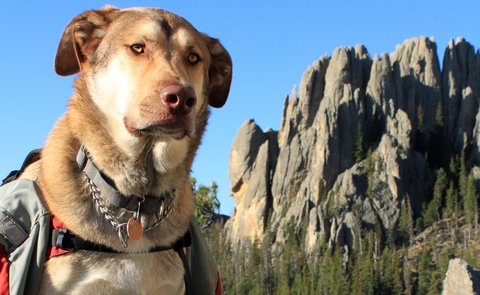As a dog lover — and owner of a 4-month old Aussie, Border collie mix — one of my greatest joys is camping with my dog, and I’m not alone.
Thousands of outdoors lovers happily venture into the wilderness with their dogs right beside them. Camping with dogs provide security and warning against threats as well as genuine companionship.
There’s a bit of work involved, though, to make sure your dog is campsite ready and below we’ve outlined just what goes into prepping man’s best friend for a night in the woods.
Training
The most important piece of dog training you’ll need on the trail is a reliable recall. Does your dog come when you call, even when there are distractions like other dogs or woodland critters? To strengthen this aspect of training, practice at a dog park to train your pooch to come when called. You can also train with a dog whistle, too, as its sound can be heard from greater distances. One other command that I’ve found to be handy is “Leave it,” which I use to get my dog to stop what she’s doing and drop what’s in her mouth (pretty much everything within distance these days).
Fitness
Exercise is the single best thing you can do for your dog, but it’s important to start slowly, as your dog’s joints can be damaged by too much distance or too much exertion too soon. I’ve heard that a good pattern is roughly 5 minutes of outside exercise for every month of your dog’s age, two times a day. For example, Bailey is 4 months now, which means 20 minutes twice a day outside. That can be a walk around the neighborhood or fetch in the backyard. Also, dogs like to work and there are many dog backpacks out there to help them carry their own water and food on the trail, but don’t have your dog carry any weight until it’s fully grown, and even then the weight shouldn’t be too heavy (around 25% of their body weight).
Baby…or, Puppy Steps
If you’re planning to take your dog on the trail, start slowly. Begin with shorter hikes, perhaps away from heavy traffic trails. Allow your puppy to try to tackle obstacles alone, too. Dogs are sturdy animals and can handle more than we think sometimes. You just want to make sure no scenario occurs where you can’t intervene quickly if needed. Learning consequences is helpful and strengthens your dog’s brain power, but you don’t want them to get hurt in the process.
Bugs and Animals
Pests like fleas and ticks are a pain on the trail and can carry diseases, so you’ll want to protect your dog with medicine like Frontline or a collar, like this one from Bayer. I’ve read that spraying coconut oil on your dog’s coat is a good preventative measure, too. Aside from bugs, predators may be a risk, depending on your region. Small dogs are at risk from coyotes and hawks, so that recall training, awareness and a leash will be useful. One other possible hazard may be venomous snakes. If you live in an area with poisonous snakes, you’ll want to look into avoidance training, which uses a snake handler and a shock collar you’ll activate whenever your dog shows interest in the handler’s snakes.
© Ryanso | Dreamstime.com – Dog and Spires








